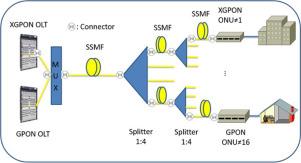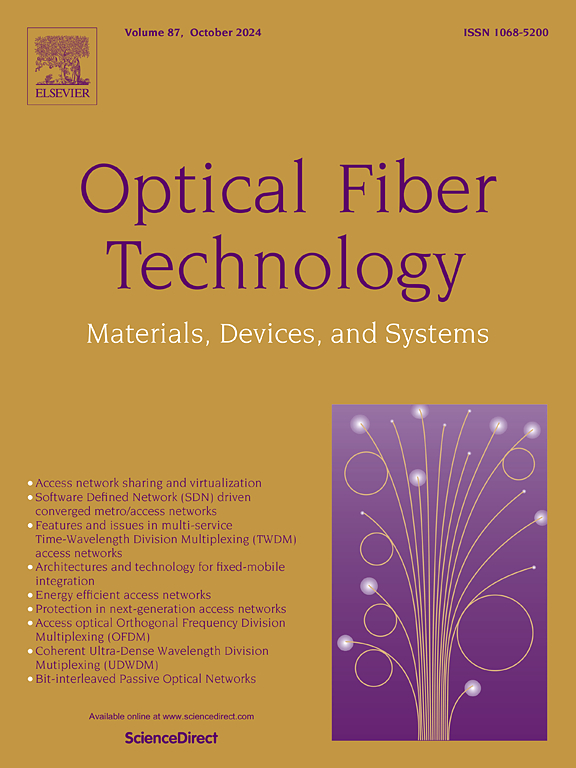Capacity Optimization of the Next-Generation Passive Optical Networks Based on Genetic Algorithm
IF 2.6
3区 计算机科学
Q2 ENGINEERING, ELECTRICAL & ELECTRONIC
引用次数: 0
Abstract
This paper proposes an analytical and a numerical models for Next Generation Passive Optical Network (NGPON) by combining Gigabit-PON (GPON) and 10 Gigabit asymmetrical PON (XGPON) technologies. This allows for a larger number of subscribers to be accommodated on the network, up to 256. A capacity optimization procedure based on Genetic Algorithm (GA) techniques is then proposed and analyzed. The uplink and downlink capacities are maximized by optimizing various link parameters, such as the number of Optical Network Units (ONUs), the average optical transmitter power, the receiver sensitivity and the network operating margins. Simulation results shown that, among others, the Distributed-feedback laser (DBF) average power, the Positive-Intrinsic-Negative (PIN) sensitivity and the network margin are the key parameters entrusted to the GA technique in order to maximize the downlink capacity. In contrast, the Fabry Perot (FP) average power, the Avalanche Photodiode (APD) sensitivity and network margin are found to be the most influential parameters optimized by GA to maximize uplink capacity. Significantly, it is demonstrated that the GA technique, when used in optimizing NGPON capacity, enabling 256 subscribers and offering a data rates up to 71.02 Gb/s and 390.56 Gb/s in the upstream and downstream directions, respectively.

基于遗传算法的下一代无源光网络容量优化
本文通过结合千兆位 PON(GPON)和万兆位非对称 PON(XGPON)技术,提出了下一代无源光网络(NGPON)的分析和数值模型。这使得网络可容纳更多用户,最多可达 256 个。随后提出并分析了基于遗传算法(GA)技术的容量优化程序。通过优化各种链路参数,如光网络单元(ONU)数量、平均光发射功率、接收器灵敏度和网络运行裕度,最大限度地提高了上行和下行链路容量。仿真结果表明,分布式反馈激光器(DBF)平均功率、正本征负(PIN)灵敏度和网络裕度是 GA 技术实现下行链路容量最大化的关键参数。相比之下,法布里-佩罗(Fabry Perot,FP)平均功率、雪崩光电二极管(Avalanche Photodiode,APD)灵敏度和网络裕度则是 GA 为实现上行链路容量最大化而优化的最有影响力的参数。值得注意的是,GA 技术在用于优化 NGPON 容量时,可使 256 个用户在上行和下行方向分别提供高达 71.02 Gb/s 和 390.56 Gb/s 的数据速率。
本文章由计算机程序翻译,如有差异,请以英文原文为准。
求助全文
约1分钟内获得全文
求助全文
来源期刊

Optical Fiber Technology
工程技术-电信学
CiteScore
4.80
自引率
11.10%
发文量
327
审稿时长
63 days
期刊介绍:
Innovations in optical fiber technology are revolutionizing world communications. Newly developed fiber amplifiers allow for direct transmission of high-speed signals over transcontinental distances without the need for electronic regeneration. Optical fibers find new applications in data processing. The impact of fiber materials, devices, and systems on communications in the coming decades will create an abundance of primary literature and the need for up-to-date reviews.
Optical Fiber Technology: Materials, Devices, and Systems is a new cutting-edge journal designed to fill a need in this rapidly evolving field for speedy publication of regular length papers. Both theoretical and experimental papers on fiber materials, devices, and system performance evaluation and measurements are eligible, with emphasis on practical applications.
 求助内容:
求助内容: 应助结果提醒方式:
应助结果提醒方式:


